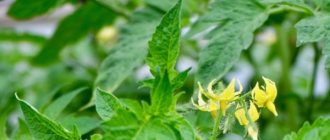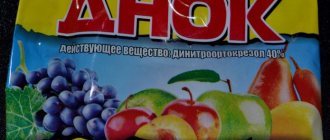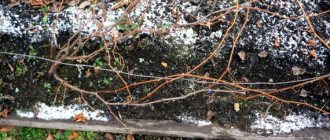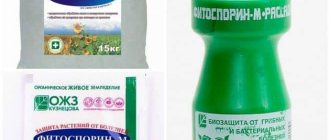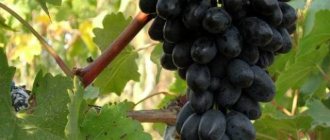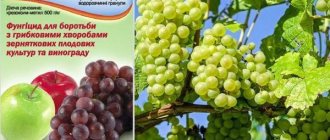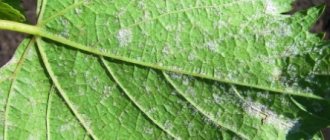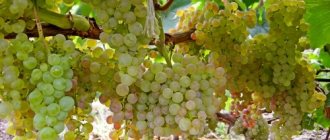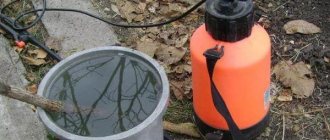Spraying grapes with vitriol is carried out to prevent and treat fungal infections. Bordeaux mixture is a traditionally used all-purpose fungicide, but it is toxic to humans and animals. Therefore, when processing, it is necessary to follow the rules of use and safety precautions.
To prevent and treat fungal infections, it is necessary to spray grapes with vitriol.
Copper as a fungicide
Copper sulfate is a contact fungicide.
Why do gardeners need copper sulfate? The thing is that copper-based preparations have a strong disinfectant effect .
They have long been used in agriculture as very effective means for the prevention and control of fungal diseases.
Copper fungicides
The industry produces products such as HOM , Kuprolux , Abiga-Pik and many others. Bordeaux mixture and Burgundy liquid based on it .
Types
Grape leaves treated with copper sulfate become covered with bluish specks.
All fungicides are divided into systemic (penetrating) and contact .
Copper compounds belong to the second group; they do not penetrate into plants - from an environmental point of view this is good.
They form a protective film on the leaves, preventing the germination and development of microfungi. But the downside is that such drugs are washed off by rain; then the protection stops.
Typically, copper-containing solutions are not recommended to be mixed with other substances (other fungicides, insecticides, fertilizers), with the exception of specially specified options.
Kinds
There are several types of vitriol. In gardening and gardening, copper and iron sulfate are used, which have a positive effect on plants.
Copper
Vitriol is a crystalline hydrate salt of sulfuric acid in combination with metals. The substance helps strengthen the plant’s immune system and helps fight fungal infections. When using it, the dosage must be observed, since exceeding it will negatively affect both the culture and human health.
Copper sulfate in single use does not pose a danger to the soil, but if it is used regularly, its accumulation will be observed, and as a result, the composition of the soil will change. If there is an excess of copper, the crop will begin to suffer from chlorosis, and the quality of the product will decrease.
Copper sulfate in the form of Bordeaux mixture can be used throughout the growing season. For the best effect, it is recommended to alternate copper and iron types.
Cobalt
Cobalt sulfate, or cobalt sulfate, is a crystalline substance that is pink or red in color. It dissolves well in liquid, but takes a long time. Widely used in the glass and ceramic industries, as a microfertilizer.
Cobalt is part of the vitamin B12 molecule. Cobalt sulfate is considered moderately toxic. If used incorrectly, it provokes disruption of the gastrointestinal tract, respiratory system, blood circulation, acute dermatitis, an allergic reaction, and affects human reproductive function. Cobalt sulfate changes the composition of the aquatic environment and is fire hazardous.
Iron
Iron sulfate is a fungicide that protects garden crops from fungal infections and can destroy mosses and lichens. Presented in the form of a light green or gray-green powder. Has good solubility in liquid.
Helps fight Alternaria blight, anthracnose, gray mold, coccomycosis, scab, powdery mildew, and grape oidium. Treatment is carried out in the autumn-spring period until the buds open and after the leaves have fallen. It should not be used as a top dressing or for treating plants by spraying green leaves. It causes burns on the crop due to increased acidity.
Manganese
Manganese sulfate is an inorganic compound that contains a salt of the metal manganese and sulfuric acid. Most often used in the textile industry. It is also an effective fertilizer. If a plant has a deficiency of manganese, it begins to suffer from chlorosis, slow growth and a delay in the flowering phase are observed.
Manganese has a positive effect on the process of photosynthesis and increases fruiting. Manganese sulfate is well suited for foliar feeding of crops such as peas, beans, and beets. It is allowed to use during pre-sowing treatment of seed material. Manganese retains moisture in plants, has a beneficial effect on plant growth and development, and increases the ability to absorb nitrogen, phosphorus and potassium.
It is not recommended to use manganese sulfate on sod-podzolic soils. Most often used as foliar feeding. The plant is treated 3 times throughout the entire season - before flowering, during flowering, and during the growth period.
Zinc
This substance is a zinc salt of sulfuric acid. Widely used in the chemical and textile industries, as well as in pharmaceuticals and veterinary medicine. It has a positive effect on the human body - antiseptic, drying and immunomodulatory effects.
The use of zinc sulfate in agronomy should not be ruled out. It is considered a universal fertilizer, which is used when there is a lack of zinc in the soil. Suitable for all types of crops. Zinc sulfate reduces ripening time, increases yield, and increases the content of sugars and vitamins. Used as foliar feeding.
Seeds of legumes, corn, and soybeans are treated with zinc sulfate during the pre-sowing period.
Nickel
Nickel sulfate is a crystalline substance, emerald or turquoise in color. Soluble in liquid, evaporates in air. It is a toxic substance, so protection is required when interacting with it. It is used more often in electroplating, the electrical industry, metallurgy, perfumery, and the chemical industry.
See also
Description of the Bogatyanovsky grape variety, planting and care rules
Read
Copper sulfate
Copper sulfate is copper pentahydrate, based on copper sulfate (copper sulfate).
Copper sulfate for the garden.
The substance is sold in gardening and hardware stores. Bright blue crystals dissolve well in warm water.
This is a toxic chemical of hazard class 2 (the most toxic is class 1). In high concentrations and when accumulated in soil, it is considered toxic to humans and fatal to fish. Plants can get severe burns during processing if the recommended dosages are not followed.
A glass (200 ml) holds 220 g of copper sulfate, a matchbox - 22 g, a tablespoon - 16 g, a teaspoon (without a slide) - 5 g.
Common mistakes when using
To achieve a positive result, you must follow the recommendations. What mistakes do gardeners, especially beginners, make when using this product:
- Incorrect dosage. This will lead to burns of the foliage and ovary, and as a result, the quality of the crop will deteriorate.
- Constant use of copper sulfate. This chemical should only be used in extreme cases.
- Failure to remove damaged and weak shoots and leaves before treatment. These areas are a place for bacteria to develop and multiply. For the best effect, the soil around the bush is loosened before the procedure.
- Failure to use protective equipment during work. If you ignore this condition, you can cause burns to the respiratory tract or the mucous membrane of the eyes, mouth, and larynx.
Areas of application
Gardeners work with an aqueous solution of copper sulfate, as well as its mixtures - Bordeaux and Burgundy liquid.
What is copper sulfate used against?
Copper sulfate is quite effective as a prophylactic agent to prevent powdery mildew in the vineyard.
It has a detrimental effect on infections:
- mildew (downy mildew);
- anthracnose;
- Alternaria blight;
- Phomopsis (black spot);
- cercospora;
- various rots (including botrytis);
- bacterial necrosis (bacterial wilt, Oleuron's disease).
Are there differences by region?
- In the northern viticulture zone, diseases are less common, and spraying on vegetative plants may not be necessary at all.
- But in the southern regions several treatments have to be carried out.
When are grape treatments needed?
Treatment of grapes with copper sulfate is carried out several times per season.
Copper sulfate is in demand in the vineyard throughout the season:
- in early spring along a dormant vine;
- during the growing season (especially in the southern regions);
- in autumn - before shelter, after leaf fall;
- for cauterizing cuts and wounds on wood;
- to protect cuttings from mold during storage.
Each case requires its own dosage standards and different concentrations of the active substance.
When is the best time to cultivate a vineyard?
The timing of spraying grapes with copper sulfate depends on the purpose for which the procedure is being carried out. There are three seasonal treatments:
- autumn - the main one, to destroy bacteria and fungi;
- spring - additional, for disinfection and disease prevention;
- summer - auxiliary, to suppress pest activity.
Based on this, it can be determined that treating vines with copper sulfate in the fall is preferable, but the importance of spring and the possibility of summer procedures cannot be ruled out. Let's take a closer look at them.
Treatment of grapes with copper sulfate in autumn
The procedure is carried out after harvesting and complete fall of leaves. Depending on the region, this could be either the beginning or the end of November. The main thing is that the bush is already prepared for winter. In this case, there is no longer any fear of the drug getting on the falling leaves; the main thing is to completely irrigate the vine and protect the plant from infection. Before processing, the grapevine is tied in a bunch along the trellis.
Processing cuttings
Mold appears much less frequently on cuttings treated with copper sulfate.
- Before storing, the cuttings are sprayed with a 4% solution of copper sulfate (40 g per 1 liter of water) or dipped in this solution (hold for 15 seconds).
- During storage, mold sometimes appears on the cuttings. It is removed with a cotton swab or cloth soaked in a solution: a teaspoon of copper sulfate (without a slide) per 250 ml of water.
Spraying on a dormant vine
in spring
At the beginning of the season, the grapes are freed from shelter, then the vine and surrounding soil are sprayed with copper sulfate.
The normal color of copper sulfate solution is bright blue.
The event is carried out strictly until the kidneys awaken. The chemical is mixed with warm water at the rate of 100 g per 10 liters of water (concentration 1%). Some gardeners alternate copper and iron sulfate between years. A solution of iron sulfate is taken at 3% .
Sometimes a combination of copper sulfate and carbamide (urea) is used. Take 500 g of urea and 50 g of copper sulfate per bucket of water. A similar solution can be used to treat the vineyard immediately before leaf fall (in the southern regions), if serious outbreaks of infections were observed in the summer.
in autumn
In the south, after leaf fall, and in shelter areas before shelter, eradicating spraying is carried out with a strong solution - 300 g of copper sulfate per 10 liters of water (concentration 3%).
Autumn spraying of the grapevine before shelter.
The drug can be replaced with iron sulfate (in a stronger concentration - 5%).
Features of use
You can spray grapes with copper sulfate in winter, spring and summer. Thanks to its composition, the solution is capable of destroying insect pests and parasitic fungi that cause diseases. It is recommended to use it not only if there are problems with the vineyard, but also to prevent the occurrence of diseases.
There is an opinion that spraying bushes with copper sulfate in the spring is dangerous. This is due to the fact that some substances in the solution can accumulate in the soil, deteriorating its fertile qualities and reducing the yield of vineyards.
If you follow the rules for using the drug specified in the instructions and adhere to the recommended doses and proportions of the solution, you will be able to avoid problems and get a high-quality harvest.
After studying the properties of copper sulfate, drugs against parasites and diseases with a wide spectrum of action were developed, retaining all the qualities of the substance, but less toxic.
Advantages and disadvantages
The use of copper sulfate for grapes has both positive and negative sides.
Advantages of the solution:
- the chemical is readily available commercially;
- the price of the drug is relatively low;
- the fungicide has a wide spectrum of action;
- copper sulfate actively destroys the fungus;
- The product is intended for the treatment of diseases and their prevention.
Disadvantages of the solution:
- high toxicity;
- the ability of a substance to accumulate in soil, plants and fruits;
- the properties of the drug have not been improved for a long time.
The disadvantages of copper sulfate also include possible burns of leaves and roots. They appear if the drug is diluted incorrectly. Despite this, grapes are still treated with copper sulfate: it has been tested for decades and its price range is very affordable, which is of great importance when owning large vineyards.
Recommendations for use
The fungicide does not combine well with fertilizing, because when it gets into the soil, it destroys not only bacteria and fungi, but also beneficial microelements contained in the soil. Any organic fertilizers applied to the soil as top dressing almost completely lose their properties during interaction with lime and copper sulfate, so it is better to treat the grapes with copper sulfate a week or a week after fertilizing.
Spraying is best done after watering
It is also not recommended to spray the fungicide before watering the bushes: there is a possibility that the water will wash the solution off the leaves. For the substance to be effective, it must remain on the plant for at least a day, especially after removing the bush from its shelter.
It is not advisable to treat grape cuttings with a pure solution: they are too sensitive to this chemical. For them, it is better to use a 4% solution prepared in the proportions of 40 g of substance per 1 liter of water. There is another treatment option: dip the cuttings in liquid for 15 seconds.
Comparison of copper and iron sulfate
Iron sulfate is less toxic and cheaper. Its advantage is that it gives the grape bushes iron, which is involved in oxidative and energy metabolism and promotes the formation of chlorophyll. Iron sulfate is used as a fertilizer and as a remedy for pests and fungal diseases. However, its insecticidal properties are not as effective as those of copper sulfate.
After treating the vineyard with iron sulfate in the spring, the buds open a few days later. Its use makes sense during frost periods to prevent the buds from dying.
Which is better - copper or iron sulfate?
Iron sulfate is slightly less toxic to humans and cheaper in price, and also supplies the vineyard with useful iron.
As a fungicide it is also quite effective , although copper is considered more effective. It should be borne in mind that after autumn and (or) spring treatment with iron sulfate, the buds on plants wake up in the spring several days later than usual (sometimes this technique is necessary to avoid the harmful effects of spring frosts).
Timing of the procedure
Grape processing times:
- in spring;
- in autumn;
- in summer.
Autumn treatment is considered the main one, spring treatment is considered additional, and treatment of the bush in summer is an auxiliary procedure if the plant needs it.
Spraying on a dormant vine in spring
Spring processing is carried out as follows:
- a few days before treatment, the vine is freed from the material that shelters it from the winter cold;
- make a solution;
- Apply the substance in an even, thin layer over the entire surface of the vine.
Important! Treatment is carried out before the buds open, and the ambient temperature should not be lower than 5 o.
Treatments for green leaves in summer
In summer, treatment is carried out as a last resort, with a solution whose concentration does not exceed 0.5%. It is advisable to carry it out at the first signs of the disease.
in autumn
It is carried out at the end of the grape harvest, when the leaves have already fallen from the bush. The best period is considered to be the beginning or end of November. It all depends on the region of residence. Before starting processing, tie a bunch of vines around the trellis.
Green leaf treatments
During the active growing season, it is recommended to treat grapes with Bordeaux mixture.
Green plant tissues are much more delicate than wood, so other methods of disease control are used.
Bordeaux liquid
When grapes enter the growing season, it is recommended to replace copper sulfate with other copper-containing products - Burgundy liquid or the more famous Bordeaux liquid. In them, caustic substances are partially neutralized, and the burning effect is much less. These fungicides have long been used by winegrowers and have proven their effectiveness. They belong to the 3rd (small) class of danger to humans and beneficial pollinating insects.
Among the disadvantages, winegrowers note that the substances are washed off by heavy rain (and then re-treatment is necessary); At the same time, a visible coating remains on the surface of the berries for a long time, which is why the presentation suffers.
Timing and dosage
The first treatment of the vine is carried out when young leaves appear.
- For preventive purposes , to prevent the emergence and development of diseases, spraying is carried out:
- in the stage of opening of the first leaves ( 2–5 pieces per shoot );
- just before flowering;
- immediately after flowering.
of 1% is usually recommended . However, it has been noticed that young leaves sometimes get burned. For the first treatment, it is better to reduce the concentration by 2 times - make a solution with a strength of 0.5% .
- If diseases do appear (for example, due to weather conditions), then spraying is repeated weekly. Sometimes contact fungicides (Bordeaux mixture) alternate with systemic ones ( Topaz, Ridomil Gold , etc.). The waiting period (from the last application to the consumption of the crop) is 3–4 weeks.
Events are carried out in calm weather, preferably late in the evening (avoiding the heat), checking the forecast for the coming days (so that rain is not expected soon).
Safety rules at work
Personal safety rules apply when working with toxic substances in the garden. They are designed to protect the skin, mucous membranes and respiratory tract of a person from the effects of poisons. Treatment should be carried out in calm weather, early in the morning or before sunset.
Before work, take personal protection measures:
- wear special clothing (robe, overalls) that covers the neck and arms up to the wrists;
- a mask or respirator is put on the face, the eyes are protected with goggles, and the hands are protected with gloves;
- there must be a hood or other covering on the head.
The spray nozzle is located at a distance of 10-20 cm from the vine, the stream is directed slightly downward. They begin to process from the upper parts of the bush, gradually moving to the trunk and root collar. After work, carefully remove the overalls and wash your face and hands with soap.
When treating plants with copper sulfate, other fungicides cannot be used simultaneously or included in the mixture. The substance is also included in many industrial pesticides (for example, HOM, Abiga-Pik, etc.). Store-bought anti-fungal preparations can be used at other times if they do not contain copper or its compounds.
During summer treatments, the last spraying with a toxic substance is carried out at least 30 days before harvesting. If this period is not observed, the berries can cause poisoning.
Rules for preparing Bordeaux mixture
Efficiency largely depends on proper mixing of components. Containers should not be metal (plastic or enameled).
Stainless steel containers are also suitable.
To obtain a bucket of 1% Bordeaux mixture, first thoroughly dissolve 100 g of copper sulfate in 5 liters of water (take warm). Then, in another container, in 5 liters of water, stir 100 g of slaked lime (or 150 g of quicklime). After this, the copper sulfate solution is poured into lime milk (and not vice versa).
The finished suspension should be opaque, sky blue in color. A greenish tone will indicate excessive acidity; you will need to add a little more lime mortar. As a result, neutral acidity is needed. This is checked using litmus paper (expect a score of 7) or a clean iron nail without rust (the iron should not be coated with copper).
The solution should not be stored for more than a day ; it is optimal to use it 1–3 hours after preparation. Residues must not be poured into water bodies.
Burgundy liquid
Burgundy liquid is made in a similar way, only the lime is replaced with baking soda or soda ash.
How to use on a grape plantation
Preparing a solution for treating a plantation has a lot of nuances, and the preparation technology depends on the method of applying the liquid. To properly prepare the medicine, follow the following preparation rules.
Prepare the solution
Gardeners who do not know how to prepare a solution of copper sulfate should adhere to the following rules:
- dissolve the substance in warm water;
- When preparing the mixture, do not forget about safety rules. Wear rubber gloves and other personal protective equipment available;
- Do not mix the solution in a container made of metal.
Dosage of copper sulfate for various treatments
Instructions for those who do not know how to dilute the substance for spraying:
- A 1% solution is prepared for spraying. Accordingly, no more than 100 grams of powder is diluted for 1 bucket of warm water;
- stir the water until the powder is completely dissolved;
- pour the resulting mixture into the sprayer.
Important! Do not mix copper sulfate solution with other chemicals. The effect of such a mixture is difficult to predict, and instead of a positive effect, you will destroy the plant, and possibly your health.
Stages and procedure for processing grapes
- shake the container with the drug;
- carefully, following safety rules, spray the substance;
- Use the remaining solution to treat trees or other plants in the area.
To avoid burning the plant, check the correct dosage by treating one leaf on the bush. If after some time no traces of burns are visible, the solution has been made correctly.
